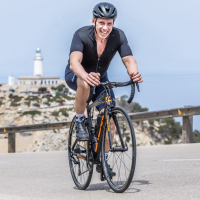Keeping your shoes dry
As it's early days I don't want to go for cycling shoes with the associated pedals etc as if I don't continue it could be wasted money. So what's your advice? Would you go with cycling overshoes and just wear them over training shoes, or some other option? Any advice would be appreciated.
Comments
-
My advice is to get used to wet feet. Water will get in through overshoes eventually.
Aim for warm and wet instead of cold and wet. Overshoes will help in this regard.
0 -
Wot ballbag said.
I’ve got a pair of winter boots, fantastic in the cold, great in the rain until the rain starts running down your leg and fills the boot. Warm and wet feet. 6 winters old now and still great.
Overshoes, not as robust or warm but will keep your feet warm if not dry.
Waterproof socks, see winter boots, cheaper but same issue and not as warm.
So I’ve ended up not bothering, winter training in the garage and outdoor riding in just shoes with the benefit of wet shoes/socks dry out relatively quickly.
75 miles on Sunday with heavy rain, drizzle, and everything in between. I just dried out and the heavens opened again. As Bally says you gotta learn to love the rain unless you move to somewhere warm, cycle friendly, Covid free or with a damn good health system centrally funded through government, allows alcohol and has tolerant laws.
One of the great aspects and beauty of cycling is that outlay doesn’t always correlate with enjoyment enjoy cycling but you’ll get to the point/ or not! where some informed purchases will enhance your enjoyment of cycling.“Give a man a fish and feed him for a day. Teach a man to fish and feed him for a lifetime. Teach a man to cycle and he will realize fishing is stupid and boring”
Desmond Tutu0 -
Best way to keep shoes dry is to leave them indoors. Otherwise, as above - and just accept that if you go out in wet weather, you will get wet. Trainers can go in the washing machine along with the kit, which will deal with the smell...0
-
Mudguards with flaps or you're just showering your feet on wet rides.
Bike shoes shrug off rain better than trainers do anyway. It's not often your entire ride would be in the rain. No point in overshoes as you'd fray the sole underneath unless you're using clipless pedals.
0 -
Many thanks for the feedback. I'm not that concerned about my feet getting wet, it was mainly the issue around 'smelly' trainers, so had wondered if overshoes were any good, but as pointed out they will just wear out underneath so probably not an option.0
-
at least for warm weather, you could look for some trainers designed for use in the wet, a quick google finds plenty, for instance...
https://www.lightinthebox.com/en/p/water-shoes-rubber-for-adults-swimming-diving_p7239576.htmlmy bike - faster than god's and twice as shiny0 -
Where would they score on the Shimano sole stiffness scale I wonder ?0
-
Overshoes are a disposable item - they get torn up but they keep the wet off/out and when the water does get in your feet are warm. Put rags or newspaper in your shoes when you get home to help them dry0
-
-
There is a solution to this. I have Sidi winter boots which are goretex lined. As slowmart says, the water will seep in the top and capillary action down your socks.slowmart said:Wot ballbag said.
I’ve got a pair of winter boots, fantastic in the cold, great in the rain until the rain starts running down your leg and fills the boot. Warm and wet feet. 6 winters old now and still great.
Overshoes, not as robust or warm but will keep your feet warm if not dry.
Waterproof socks, see winter boots, cheaper but same issue and not as warm.
So I’ve ended up not bothering, winter training in the garage and outdoor riding in just shoes with the benefit of wet shoes/socks dry out relatively quickly.
75 miles on Sunday with heavy rain, drizzle, and everything in between. I just dried out and the heavens opened again. As Bally says you gotta learn to love the rain unless you move to somewhere warm, cycle friendly, Covid free or with a damn good health system centrally funded through government, allows alcohol and has tolerant laws.
One of the great aspects and beauty of cycling is that outlay doesn’t always correlate with enjoyment enjoy cycling but you’ll get to the point/ or not! where some informed purchases will enhance your enjoyment of cycling.
To solve this I have used two different solutions which keep the water out significantly longer. The first is neoprene gaiters, only about 5-6” long which you put around your leg first, roll up, put your boot on and then roll down over the boot top. They are a snug fit which helps prevent the capillary action, and obviously being placed over your boot top stops water running in. They keep my feet dry for significantly longer than just the boot.
Alternatively, and the only solution I have found which keep my feet dry and warm for hours on end are Spatz overshoes. These come all the way up your calf. They are a right faff to put on, but in the depths of a wet winter 6hr ride the faff is worth it.
I put my socks on first, leg warmers (I don’t wear bib tights) next, which I roll up to the knee. Now put the Spatz on and roll them up. Boot on, Spatz rolled down over the boot. Top of the Spatz ideally wants to be against bare skin above your sock top for best seal. Then finally roll the leg warmer down over the Spatz. Warm and dry for hours.
PP0




